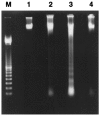Simvastatin inhibits cancer cell growth by inducing apoptosis correlated to activation of Bax and down-regulation of BCL-2 gene expression
- PMID: 22134829
- PMCID: PMC3584570
- DOI: 10.3892/ijo.2011.1273
Simvastatin inhibits cancer cell growth by inducing apoptosis correlated to activation of Bax and down-regulation of BCL-2 gene expression
Abstract
The statins (3-hydroxy-3-methylglutaryl coenzyme A reductase inhibitors) have been proven to be effective in lowering cholesterol and as anti-lipid agents against cardiovascular disease. Recent reports demonstrate an anticancer effect induced by the statins through inhibition of cell proliferation. Probably, these effects are due to suppression of the mevalonate pathway leading to the depletion of various downstream products that play an essential role in cell cycle progression, cell signaling and membrane integrity. To date, although many hypotheses have been proposed, the exact mechanism at the basis of cancer cell growth arrest induced by statins is not known. In this study, we have demonstrated that simvastatin, at a dose of 20 µM for 24-72 h, induced in cancer cells but not in normal cells precise features of apoptosis including increased DNA fragmentation while, at the molecular level simvastatin induced overexpression of the pro-apoptotic gene Bax together with an inhibition of BCL-2, the gene that has the well-known function of protecting cells from apoptosis. The simvastatin-mediated induction of apoptosis in similar cancer cells but not in normal cells is very interesting and may be at the basis of cancer therapy using statins, usually in combination with chemotherapy or to be used as a cancer protective drug. Simvastatin may, thus, play a dual prophylactic role as a lipid-lowering drug for the prevention of heart disease and as an anticancer agent to prevent certain types of cancers.
Figures





Similar articles
-
Inhibition of Barret's adenocarcinoma cell growth by simvastatin: involvement of COX-2 and apoptosis-related proteins.J Physiol Pharmacol. 2007 Aug;58 Suppl 3:141-8. J Physiol Pharmacol. 2007. PMID: 17901590
-
Hydroxymethylglutaryl-coenzyme A reductase inhibitors induce apoptosis in human cardiac myocytes in vitro.Biochem Pharmacol. 2006 Apr 28;71(9):1324-30. doi: 10.1016/j.bcp.2006.01.016. Epub 2006 Mar 15. Biochem Pharmacol. 2006. PMID: 16540096
-
HMG-CoA reductase inhibitors induce apoptosis of lymphoma cells by promoting ROS generation and regulating Akt, Erk and p38 signals via suppression of mevalonate pathway.Cell Death Dis. 2013 Feb 28;4(2):e518. doi: 10.1038/cddis.2013.44. Cell Death Dis. 2013. PMID: 23449454 Free PMC article.
-
Statins, stem cells, and cancer.J Cell Biochem. 2009 Apr 15;106(6):975-83. doi: 10.1002/jcb.22092. J Cell Biochem. 2009. PMID: 19224538 Review.
-
Statins, Bcl-2, and apoptosis: cell death or cell protection?Mol Neurobiol. 2013 Oct;48(2):308-14. doi: 10.1007/s12035-013-8496-5. Epub 2013 Jul 3. Mol Neurobiol. 2013. PMID: 23821030 Free PMC article. Review.
Cited by
-
Atorvastatin Protects NSC-34 Motor Neurons Against Oxidative Stress by Activating PI3K, ERK and Free Radical Scavenging.Mol Neurobiol. 2016 Jan;53(1):695-705. doi: 10.1007/s12035-014-9030-0. Epub 2015 Jan 11. Mol Neurobiol. 2016. PMID: 25577170
-
Lifestyle and Environmental Approaches for the Primary Prevention of Hepatocellular Carcinoma.Clin Liver Dis. 2020 Nov;24(4):549-576. doi: 10.1016/j.cld.2020.06.002. Epub 2020 Aug 25. Clin Liver Dis. 2020. PMID: 33012445 Free PMC article. Review.
-
Impact of oral statin therapy on clinical outcomes in patients with cT1 breast cancer.BMC Cancer. 2023 Mar 9;23(1):224. doi: 10.1186/s12885-023-10631-w. BMC Cancer. 2023. PMID: 36894884 Free PMC article.
-
MiR-590-5p regulates cell proliferation, apoptosis, migration and invasion in oral squamous cell carcinoma by targeting RECK.Histol Histopathol. 2021 Mar;36(3):355-365. doi: 10.14670/HH-18-306. Epub 2021 Jan 15. Histol Histopathol. 2021. PMID: 33447989
-
Knockdown of TRIM65 inhibits lung cancer cell proliferation, migration and invasion: A therapeutic target in human lung cancer.Oncotarget. 2016 Dec 6;7(49):81527-81540. doi: 10.18632/oncotarget.13131. Oncotarget. 2016. Retraction in: Oncotarget. 2024 May 16;15:312. doi: 10.18632/oncotarget.28571. PMID: 27829229 Free PMC article. Retracted.
References
-
- Gauthaman K, Fong CY, Bongso A. Statins, stem cells, and cancer. J Cell Biochem. 2009;106:975–983. - PubMed
-
- Goldstein JL, Brown MS. Regulation of the mevalonate pathway. Nature. 1990;343:425–430. - PubMed
-
- Lee MH, Yee Cho S, Han YM. Simvastatin suppresses self-renewal of mouse embryonic stem cells by inhibiting RhoA geranylgeranylation. Stem Cell. 2007;25:1654–1663. - PubMed
-
- Chan KK, Oza AM, Siu LL. The statins as anticancer agents. Clin Cancer Res. 2003;9:10–19. - PubMed
Publication types
MeSH terms
Substances
LinkOut - more resources
Full Text Sources
Medical
Research Materials

